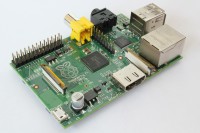
As you may’ve guessed from some previous blog posts, I have been expirementing with Raspberry Pi as media player.
The setup was not entirely straight forward, as it was to be located at my girlfriends place, with access to the media I have at home.
I was looking at OpenVPN as solution, tying the networks together. She has ample down link (16Mb/s), and I have ample uplink (12Mb/s) to make this viable.
I started testing with my laptop as media player, and 720p played just fine from a NFS volume mounted over OpenVPN. A few glitches during playback if the connection was used for anything else whilst playing, but quite smooth and usable.
1080p, however, was no go. Low BW 1080p might work, but probably not. The solution for this was Plex, with a suitable plugin in XBMC. Plex handles on-the-fly transcoding to a more suitable bandwidth profile.
After testing a bit, my conclusion was that the solution was not performing well enough. Throughput was 2-3Mb/s over the OpenVPN-link. Originally I believed this was due to the limited CPU power of the Pi, but it turned out that the Edimax Wireless USB adapter was the culprit. When testing at home, it was placed 50cm from the antennas of my access point; not the setup at my girlfriends place. There it was 5 meters…
Changing to cabled gave a throughput of roughly what the link should be able to carry (11.5Mb/s according to Samknows), minus overhead. So actual throughput was 10.5-11Mb/s downstream, and 4.5-5Mb/s upstream, tested with iperf/.
Plex setting at 8Mb/s was working nice – if connection was not used for other stuff at same time. Right now it’s set to 4Mb/s, which leaves quite a bit of headroom for other stuff.
I run the OpenVPN in a bridged setup, to avoid routing or any such things – easier to integrate the two LAN’s in bridged mode. Performance is acceptable enough, and the added benefit is that I can use everything as if at home no matter where I am 🙂
Right now, it’s running on cable, and I’m looking for a cheap and good wireless stick, well supported by Linux…
(Oh. OpenVPN setup looks difficult, but it’s rather easy once you actually grok it. The client config file can be as short as this:
client
remote foobar.example.org
proto udp
dev tap0
ca ca.crt
cert client2.crt
key client2.key
script-security 2
up /etc/openvpn/update-resolv-conf
down /etc/openvpn/update-resolv-conf